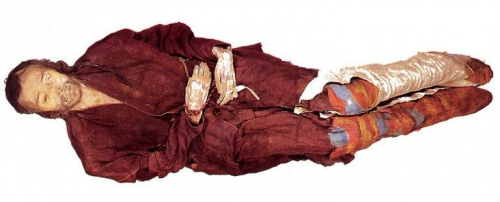« Oswald Spengler's Apocalyptic Vision of History | Page d'accueil | Le testament de Guillaume Faye »
lundi, 20 janvier 2020
Caucasian Tarim Mummies, Tocharians and other Indo-Europeans of China

Caucasian Tarim Mummies, Tocharians and other Indo-Europeans of China
Archaeological discovery of mummies in the Taklamakan desert of Western China dating back 4,000 years has captivated the imaginations of researchers, who were surprised to discover that they were caucasians from Europe. The answers to the mystery of who these white mummies were might be found in the later history of Xinjiang province; in the Chinese written records of blue eyed and red bearded merchants such as the Yuezhi and the Sogdians from the West and in the manuscripts written in a mysterious Indo-European language known as Tocharian. Clearly there were both Iranic and Tocharian peoples living in Western China in later times, and the Tarim mummies must have been the ancestors of some if not all of them.
The inhospitable Tarim basin became a vital route for merchants, at the crossroads between East and West, the basin is skirted by oasis towns which were stations for anyone traveling on the Silk Road.The caucasian, Europoid mummies and the ancient Indo-European languages of the region challenge popular misconceptions about the limits of European civilisation in the Bronze Age. The material excavated suggests the area was active for thousands of years, with diverse languages, lifestyles, religions, and cultures present.
This channel depends on your support:
Subscribestar: https://subscribestar.com/survive-the...
Facebook: https://www.facebook.com/SurviveTheJive
Twitter: https://twitter.com/SurvivetheJive
Tocharians and Tarim mummies art by Andrew Whyte http://basileuscomic.com/
Andronovo chariot art by Christian Sloan Hall https://www.deathlord.co.uk
Music:
OST by Deor (website coming soon) Doug maxwell - Lau Tzu Ehru Doug Maxwell - Oud dance Quincas moreira - Dawn of Man Kevin McLeod - Dhaka
Sources:
Adams, D., (2019) ‘Tocharian C: its discovery and implications’ https://languagelog.ldc.upenn.edu/nll...
A dictionary of Tocharian B https://www.win.tue.nl/~aeb/natlang/i...
Gray, Russell & Atkinson, Quentin & Greenhill, Simon. (2011). Language Evolution and Human History. Good, I., ‘A Social Archaeology of Cloth some preliminary remarks on prehistoric textiles of the Tarim Basin’ (Peabody Museum) http://www.safarmer.com/Indo-Eurasian...
Hollard, C. et al. (2018). New genetic evidence of affinities and discontinuities between bronze age Siberian populations. American Journal of Physical Anthropology 167 (1): 97–107. Katariya, A., ‘Ancient History of Central Asia: Yuezhi-Gurjar History’, Article No 01 Mair, V., ‘Ancient Mummies of the Tarim Basin’ https://www.penn.museum/sites/expedit...
Ning, et al. (2019), ‘Ancient Genomes Reveal Yamnaya - Related Ancestry and a Potential Source of Indo-European Speakers in Iron Age Tianshan’ https://www.cell.com/current-biology/...
Wenkan, X. (1996) ‘The Tokharians and Buddhism’ Xie, M. et al, (2013) Interdisciplinary investigation on ancient Ephedra twigs from Gumugou Cemetery (3800 B.P.) in Xinjiang region, northwest China. https://www.ncbi.nlm.nih.gov/pubmed/2...
Yang, Y. (2019), ‘Shifting Memories: Burial Practices and Cultural Interaction in Bronze Age China A study of the Xiaohe-Gumugou cemeteries in the Tarim Basin’ http://www.diva-portal.org/smash/get/...
Selections from the Han Narrative Histories https://depts.washington.edu/silkroad...
00:05 Publié dans archéologie | Lien permanent | Commentaires (1) | Tags : tokhariens, momies du tarim, indo-européens, archéologie, ethnologie, anthropologie, asie centrale, tarim |  |
|  del.icio.us |
del.icio.us |  |
|  Digg |
Digg | ![]() Facebook
Facebook



Commentaires
C'est quoi pour une idiotie? On met à toutes les sauces le caractère "indo-européen". L'indo-européen représente une famille linguistique et rien d'autre, encore moins raciale. Les tokhariens n'appartient nullement à ce groupe linguistique, et conversaient très bien avec les Hatti et non avec les Scythes et Cie. Tout comme dire que les Hittites étaient indo-européens est une farce grotesque. Les Hatti descendent de Sumer qui, eux-mêmes, proviennent d'Inde du Sud.
Écrit par : MBM | samedi, 29 février 2020
Les commentaires sont fermés.